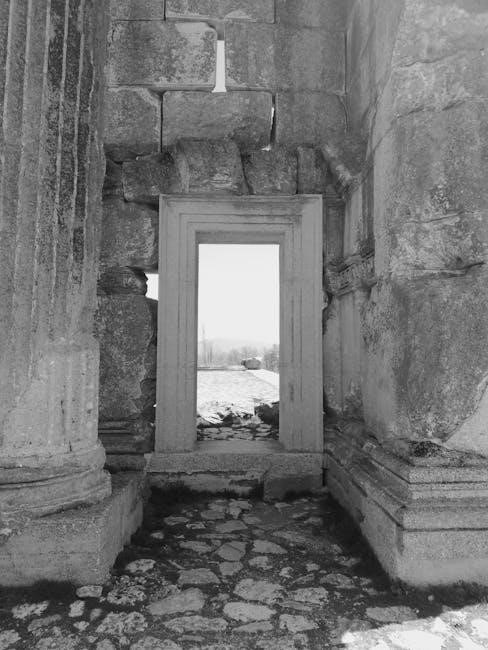
aci 301 pdf
ACI 301 is a vital standard for structural concrete, published by the American Concrete Institute, providing comprehensive guidelines for construction projects. It ensures durability, safety, and quality in concrete structures, addressing materials, reinforcement, and finishing. Widely recognized, ACI 301 is accessible as a PDF for easy reference, making it a cornerstone for engineers and contractors worldwide.
1.1 Overview of ACI 301 Specifications
ACI 301 provides detailed guidelines for structural concrete construction, covering materials, reinforcement, formwork, and finishing. It ensures compliance with industry standards, addressing durability and structural integrity. The specification is widely used in construction projects, offering a framework for achieving high-quality concrete work. Available as a PDF, ACI 301 serves as a critical resource for engineers and contractors, outlining best practices for concrete placement and architectural concrete finishes.
1.2 Importance of ACI 301 in Structural Concrete
ACI 301 is essential for ensuring the quality and longevity of structural concrete elements. It establishes standards for materials, testing, and construction practices, minimizing defects and enhancing safety. By adhering to ACI 301, professionals ensure compliance with industry best practices, reducing risks and improving project outcomes. Its guidelines are critical for achieving durable and aesthetically pleasing concrete structures, making it a fundamental resource in modern construction.
Scope and Purpose of ACI 301
ACI 301 provides specifications for structural concrete, covering materials, reinforcement, formwork, and placement. Its purpose is to ensure quality, durability, and compliance in construction projects.
2.1 Key Objectives of the Specification
The primary objectives of ACI 301 are to establish standards for constructing structural concrete, ensuring quality, safety, and durability. It focuses on proper materials, testing, and construction practices to meet design requirements. The specification aims to guide engineers, contractors, and inspectors in achieving consistent and reliable outcomes. By addressing detailing, placement, and curing, ACI 301 promotes long-term performance and minimizes potential defects in concrete structures, aligning with industry best practices and building codes.
2.2 Applicability in Construction Projects
ACI 301 is widely applicable to various construction projects involving structural concrete. It serves as a foundational guide for building design, ensuring compliance with safety and durability standards. The specification is particularly relevant for high-rise buildings, bridges, and infrastructure projects. By providing detailed construction practices, ACI 301 helps engineers and contractors achieve consistent results. Its applicability extends to both new constructions and repairs, making it a versatile resource for the concrete construction industry. Proper implementation ensures structural integrity and long-term performance.

Structural Concrete Requirements
ACI 301 outlines essential requirements for structural concrete, including materials, testing standards, and construction practices, ensuring durability and safety in building designs.
3.1 Materials and Testing Standards
ACI 301 specifies requirements for materials used in structural concrete, including cement, aggregates, admixtures, and reinforcement. It outlines testing procedures to ensure compliance with strength, durability, and workability standards. Slump tests, compressive strength evaluations, and air content measurements are emphasized. Adherence to ASTM standards is mandated for material quality. Proper testing ensures concrete meets design specifications, promoting long-term structural integrity and safety in construction projects.
3.2 Reinforcement and Bonding Requirements
ACI 301 provides detailed guidelines for reinforcement in structural concrete, including steel reinforcement bars (rebar) and fiber-reinforced polymers. It specifies requirements for spacing, cover, and placement to ensure proper bonding between concrete and reinforcement. Tension and compression lap splices, as well as mechanical connections, are addressed. The specification emphasizes proper detailing to prevent reinforcement corrosion and ensure load transfer efficiency. Adherence to these requirements enhances structural durability and safety in concrete construction projects.

Formwork and Concrete Placement
ACI 301 outlines requirements for formwork design, fabrication, and concrete placement, ensuring structural integrity and surface quality while maintaining safety and compliance with construction standards.
4.1 Design and Fabrication of Formwork
ACI 301 provides detailed guidelines for the design and fabrication of formwork, emphasizing safety, durability, and precision. It covers load calculations, material selection, and construction tolerances to ensure proper concrete placement. The specification also addresses shoring systems, form ties, and surface finishes, ensuring compliance with engineering principles and project requirements. Proper formwork design is critical to achieving the desired structural and aesthetic qualities of concrete elements, making it a cornerstone of successful construction projects.
4.2 Concrete Placement and Finishing Techniques
ACI 301 outlines best practices for concrete placement and finishing, ensuring proper consolidation and surface quality. It emphasizes the use of vibrators for eliminating air pockets and trowels for achieving smooth finishes. Timing, temperature control, and curing methods are also addressed to prevent defects. Adherence to these techniques ensures structural integrity, durability, and aesthetic appeal, making them essential for successful project execution. Proper finishing enhances concrete’s performance and longevity in various environmental conditions.
Architectural Concrete
Architectural concrete combines engineering with artistry, focusing on aesthetic and structural design. It emphasizes unique surface finishes, textures, and visual appeal for decorative and functional applications in construction.
5.1 Definition and Design Considerations
Architectural concrete, as defined by ACI 301, refers to concrete structures designed to enhance visual appeal while maintaining structural integrity. Design considerations include selecting materials for desired textures and colors, ensuring proper formwork to achieve intricate shapes, and planning finishes to meet aesthetic requirements. Factors like durability, weather resistance, and maintenance are also critical. ACI 301 provides guidelines to balance artistic expression with structural performance, ensuring safety and longevity in architecturally significant concrete elements.
5.2 Surface Finish and Aesthetic Requirements
ACI 301 outlines specific surface finish and aesthetic requirements for architectural concrete, emphasizing consistency and quality. It covers various finishes, such as smooth, textured, or patterned surfaces, achieved through specialized formwork and techniques. The specification addresses color uniformity, pattern repetition, and defect repair, ensuring the final appearance aligns with design intent. Proper curing and surface protection are also highlighted to maintain durability and visual appeal, balancing functional and aesthetic demands in concrete construction.
Inspection and Testing
ACI 301 pdf emphasizes rigorous inspection and testing to ensure compliance with structural and aesthetic standards, covering materials, processes, and finished concrete elements to maintain quality and safety.
6.1 Quality Control Measures
ACI 301 pdf outlines quality control measures to ensure compliance with structural and aesthetic requirements. It mandates thorough material verification, including concrete, reinforcement, and formwork inspections. The specification emphasizes proper testing protocols, such as slump tests, air content measurements, and cylinder tests, to verify concrete strength. Documentation of all inspections and tests is required, with corrective actions specified for non-compliant elements. These measures ensure high-quality construction and adherence to design specifications.
6.2 Testing Procedures for Compliance
ACI 301 pdf details specific testing procedures to verify compliance with design and material requirements. These include concrete strength tests, such as cylinder tests and field-cured specimens, to ensure compliance with specified compressive strength. Additionally, slump tests are conducted to assess workability, and reinforcement placement inspections are performed to confirm alignment and spacing. Testing is typically conducted during concrete placement and after curing, with results compared against acceptance criteria to ensure structural integrity and durability.

Corrosion Mitigation in Reinforcement
ACI 301 emphasizes corrosion mitigation through epoxy-coated reinforcement and cathodic protection. Proper concrete cover and environmental considerations are crucial for durability.
7.1 Causes of Corrosion in Concrete Structures
The primary causes of corrosion in concrete structures include environmental factors such as exposure to chlorides from deicers or seawater, and carbonation, which reduces the concrete’s pH. Poor concrete quality, inadequate cover, and cracks in the concrete also contribute. Additionally, design flaws, such as insufficient drainage or improper material selection, can accelerate corrosion. These factors compromise the protective alkaline environment around reinforcement, leading to steel degradation and structural integrity loss over time.
7.2 Protective Measures and Treatments
Protective measures against corrosion in concrete structures include the use of epoxy-coated reinforcement, cathodic protection systems, and corrosion-inhibiting admixtures. Proper concrete cover thickness, low water-cement ratios, and adequate curing are essential. Surface sealers and protective coatings also prevent chloride ingress. Regular inspections and maintenance, such as repairing cracks and spalling, further mitigate corrosion risks. ACI 301 emphasizes these proactive strategies to ensure durability and extend the service life of concrete structures, safeguarding the reinforcement from environmental and chemical degradation.

Historical Development of ACI 301
ACI 301 was first introduced to standardize structural concrete construction practices, evolving over decades to align with advancing technologies and industry needs, becoming a foundational guide.
8.1 Evolution of the Specification
The ACI 301 specification has undergone significant revisions since its initial publication in 1964. It began as a guide for structural concrete construction, focusing on standardizing practices. Over the years, updates incorporated advancements in materials, testing methods, and construction techniques. Revisions addressed emerging challenges, ensuring alignment with modern engineering demands. Each update reflected industry feedback, making it a comprehensive resource for professionals. The evolution underscores ACI’s commitment to improving construction standards and safety through continuous refinement.
8.2 Key Revisions and Updates
ACI 301 has undergone numerous revisions to reflect advancements in concrete technology. The 2005 update introduced enhanced provisions for self-consolidating concrete, while the 2016 version emphasized sustainability and durability. Recent updates include revised testing protocols for materials and expanded guidelines for reinforced concrete. These changes ensure the specification remains aligned with industry practices and addresses emerging challenges. Each revision strengthens the document’s relevance, providing clearer guidance for engineers and contractors to meet modern construction demands effectively.

Comparison with Other ACI Specifications
ACI 301 focuses on structural concrete, differing from ACI 318’s building codes and ACI 347’s repair guidelines, yet complementing them in construction projects.
9.1 ACI 301 vs. ACI 318
ACI 301 focuses on specifications for structural concrete construction, while ACI 318 provides the building code for structural concrete. ACI 301 details construction practices, materials, and placement, whereas ACI 318 establishes design and analysis requirements. Both are essential but serve different roles. ACI 301 ensures construction aligns with design intent, complementing ACI 318’s focus on safety and performance. Together, they form a comprehensive framework for concrete structures, addressing both construction and design aspects.
9.2 ACI 301 vs. ACI 347
ACI 301 and ACI 347 differ in scope and application. ACI 301 focuses on structural concrete construction, covering materials, testing, and placement. ACI 347, however, specifically addresses concrete formwork, detailing design, fabrication, and safety requirements. While ACI 301 is broader, encompassing overall construction practices, ACI 347 is specialized, ensuring formwork durability and structural integrity. Both standards complement each other, with ACI 301 guiding general concrete construction and ACI 347 focusing on the critical aspect of formwork in achieving precise and durable structures.

Availability and Access
The ACI 301 PDF is accessible via the official ACI website, authorized resellers, and select online platforms. Purchase options include single-user licenses, subscriptions, or bundled standards.
10.1 How to Download ACI 301 PDF
To download the ACI 301 PDF, visit the official ACI website or authorized resellers. Search for “ACI 301” in the standards section, select the PDF format, and proceed to checkout. Payment is typically required, with options for single-user licenses or subscriptions. After payment, the PDF is available for immediate download. Ensure compliance with licensing terms to avoid copyright infringement. For the most reliable access, use official ACI channels or verified sellers to obtain the document.
10.2 Purchase and Subscription Options
ACI 301 can be purchased as a one-time PDF download or through subscription plans. Subscriptions often include access to updated versions and multiple standards. Individual licenses are ideal for single users, while organizational licenses suit teams. Discounts are available for bulk purchases or long-term subscriptions. Visit the ACI store or authorized distributors to explore pricing tiers and subscription models. Ensure to purchase from official sources to guarantee authenticity and compliance with licensing agreements.

Practical Applications
ACI 301 provides practical guidelines for structural concrete construction, ensuring durability, safety, and compliance with industry standards in real-world engineering and architectural projects.
11.1 Case Studies and Real-World Examples
ACI 301 has been instrumental in high-profile projects like the construction of large infrastructure and high-rise buildings, ensuring compliance with strict structural integrity standards. Real-world examples include its application in bridge decks, where its guidelines for formwork and concrete placement minimized defects and enhanced durability. Additionally, architectural concrete projects have benefited from its surface finish recommendations, achieving desired aesthetics while maintaining structural strength. These case studies highlight ACI 301’s versatility and effectiveness in practical construction scenarios.
11.2 Benefits of Implementing ACI 301
Implementing ACI 301 ensures adherence to standardized practices, improving the quality and durability of concrete structures; It minimizes construction errors by providing clear guidelines, reducing costly repairs. Compliance with ACI 301 enhances safety, meeting regulatory requirements and protecting against structural failures. Additionally, it streamlines project workflows, fostering collaboration among contractors, engineers, and architects. The specification’s emphasis on quality control and testing ensures long-term performance, making it a critical resource for achieving successful and sustainable concrete construction projects.

Frequently Asked Questions
This section addresses common inquiries about ACI 301, providing clarity on its application, interpretation, and compliance requirements for structural concrete construction projects.
12.1 Common Queries About ACI 301
Common questions about ACI 301 often revolve around its scope, application, and compliance requirements. Many users inquire about the differences between ACI 301 and other specifications, such as ACI 318, and how to interpret specific provisions. Others seek clarification on testing procedures, materials, and formwork standards. Additionally, questions about accessing the ACI 301 PDF, updates to the specification, and its relevance to various construction projects are frequently asked. These queries highlight the importance of understanding the document’s practical applications.
12.2 Clarifications on Key Provisions
Clarifications on ACI 301 often address specific technical aspects, such as material requirements, inspection frequencies, and formwork design. Users seek details on interpreting tolerance limits, repair procedures for defects, and compliance with local building codes. Additionally, clarifications may cover issues like concrete curing methods, reinforcement spacing, and testing frequencies. These explanations ensure proper implementation of the specification, resolving ambiguities and ensuring adherence to industry standards.

References and Further Reading
For deeper understanding, refer to ACI 301, ACI 318, and ACI 347. Visit the official ACI website for access to these publications and related guides.
13.1 Related ACI Publications
ACI 301 is complemented by other ACI standards, such as ACI 318 for building code requirements and ACI 347 for concrete formwork. ACI 224 focuses on cracking, while ACI 363 addresses high-strength concrete. ACI 546 covers repair materials. These publications provide comprehensive guidance on design, construction, and maintenance. For detailed insights, refer to the official ACI website or purchase these documents through authorized platforms.
13.2 Recommended Resources for Deeper Understanding
For a deeper understanding of ACI 301, explore ACI’s educational resources, including training courses, webinars, and technical guides. The ACI Concrete Knowledge Center offers comprehensive materials. Additionally, third-party textbooks and industry journals provide practical insights. Online forums and professional networks, like ACI Committees, facilitate discussions and knowledge sharing. Visit the official ACI website or authorized distributors for access to these resources and enhance your expertise in structural concrete construction.

Leave a Reply
You must be logged in to post a comment.